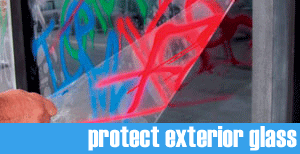Blackout Store Windows
Businesses and contractors always call us about having us blackout store windows for them. In most cases they are planning to build a wall, set up shelving, or hide plumbing that is directly in front of a section of windows. This solution saves thousands of dollars and weeks of labor that would normally go into removing the windows to put up a wall.
Unfortunately blackout tint is not safe for most store front windows that are going to get hit with sun. This is because when exposed to sunlight, blackout tint causes glass to absorb high amounts of heat which can cause it to expand and break.
Fortunately there is an alternative to traditional blackout for store windows – whiteout film. Whiteout is an opaque polyester film which duplicates the benefits of blackout tint without the risk of glass breakage. Whiteout film is thick, so even framing, plumbing or shelving which is directly behind the film is completely obscured.
Here are some of the risks of using blackout tint instead of whiteout film:
Single Pane, Tempered
In most cases we only install blackout tint on windows that are tempered and single pane. Tempered windows are heat-strengthened (just like the passenger windows on cars), so they can stand up to the added stress of the tint without breaking.
Single Pane, Annealed (Not Tempered)
The only other type of glass we occasionally apply blackout tint to are those that are annealed and single pane. This can still be risky – especially on larger windows. If there are any unseen chips along the edge of the glass, or if the glass was not installed properly (not given a proper amount of room for natural expansion) – breakage can still occur when the glass is exposed to sunlight.
Double Pane, Annealed
Blackout tint applied to double-pane glass causes the inner pane (the pane that the film is applied to) to heat up and expand in the sun while the outer pane remains cooler and does nothing. Since both panes of glass are glued together, this leads to the two panes of glass fighting with each other until one of them breaks.
Double Pane, Tempered
Even if your double-pane glass is tempered, you may not have to worry about breakage, but you do have to worry about seal failure. Seal failure is when the airspace between the panes of glass is split open. Not only does this affect the insulative properties of the glass, but allows moisture to build up between the glass, which will eventually fog the glass and ultimately begin to mold.
Just to recap: The safest glass for blackout tint is single pane, preferably tempered. If your windows are double pane, blackout tint is not recommended.
If your application requires the black color of blackout tint you can always have the tint installed on the outside of the glass. Since the tint is exposed to cooling breezes, the temperature of the glass doesn’t get out of hand. This means that no matter what type of glass you have, you won’t have to worry about thermal breakage, only film longevity. You will probably have to remove and replace the film every 2-5 years if you install it outside, as blackout tint is not specifically designed to stand up to outdoor use. Whiteout film properly installed to the inner face of the glass lasts much longer and it will probably be around 10-15 years before you have to worry about any type of maintenance.
Another option we offer our clients is frosted film. Costing no more to install than whiteout film, you can get the beautiful look of frosted windows to hide whatever is behind the glass. The only drawback to frosted film over whiteout film is that the lower opacity allows you to sometimes see things that are closer than a foot to the glass. If this isn’t an issue for your application, you have the choice of using either product. The advantage to frosted film over whiteout film is that frosted film allows nearly all of the natural light to pass through the window while whiteout film almost blocks it all.
If you have an upcoming project in the Chicago area and would like to get a free quote, give us call at 800-683-8468 or click here to contact us.





